My expectations of Nepali food were not very high before we went there. I was picturing an endless stream of nearly identical dal bhat meals (rice with lentils and curry vegetables). It also occurred to me that the mountainous landscape might not yield a huge variety of fresh produce, and meat could be either very expensive or handled in such a way that I wouldn’t want to eat it. We were coming from northern India, after all, where the norm is “veg” and the deviation from the norm is “non-veg.” We were warned by many people in India, mostly locals, about the dangers of eating meat, particularly in urban areas. If anything, I thought Nepal would be even worse since it is not known for it’s high standards of cleanliness. Most of the staples of the mountainous regions in the far north of India were heavy on carbs and not-so-heavy on bold flavors and variety. Potatoes, various breads, and noodles with thick creamy sauces. I guess I thought Nepal would be the same. I’m pretty sure Nepalis don’t appreciate being compared to their big domineering neighbor India but one can’t deny that geographically it would make sense for there to be a lot of similarities between Nepal and the Himalayan regions of India.
Fortunately my preconceived notions about Nepali food were completely wrong. We definitely encountered some dal bhat, which was occasionally delicious, but usually nothing special. In Pokhara, surprisingly, our dal bhats turned out to be somewhat disappointing. The best ones were on long bus routes at roadside eateries specifically set up for busses and other long distance travelers. For about 20 or 30 minutes everybody gets off the bus to quickly eat – the Nepali equivalent of an Indian dhaba. I suspect that over time the bus drivers develop an affinity for certain places which means they bring in a lot of business and it is definitely worth it for these places to step up their game to get a piece of that action with good value and a truly satisfying meal. They all essentially serve a version of dal bhat, with enormous cauldrons of each dish ready-made but there is some variation. There is always rice, dal (soupy lentils, split peas, mung beans, or other legumes), and some sort of curried vegetable (usually cauliflower or potato) but other side dishes can be included. One of the most common which happens to be a favorite of mine is saag – stewed spicy mustard greens. Think American southern-style collard greens minus the ham hock and with a pungent, almost horse-radishy kick. I could eat that every day for the rest of my life. Some of the dals were pretty good too and some places had a knack for working with cauliflower. Between India and Nepal I developed a whole new appreciation for cauliflower. It is grown everywhere throughout the mountainous regions, available at all the markets, and many people grow small crops of it at home along with greens. One of the better dinner stops even had a big pile of whole smoked fish, trout I think, that could be added to the meal. The typical format for dal bhat is that they come around with seconds if you want which is nice. Some restaurants in town would give us a big pile of rice with about a tablespoon of each other dish but these roadside bus stop shacks loaded our plates with the good stuff.
With a lack of meat in our diets in India, Fern and I had a serious protein craving built up. As we wandered the streets of Kathmandu we were surprised to find a lot of meat available. Kathmandu has a strong Newari presence which not only means that there are lots of gorgeous old buildings everywhere but also that Newari food is easy to find. The Newars are a prominent ethnic group in central Nepal who built some of the larger and more prosperous communities. None of the reading that I did before going to Nepal really made it clear how good Newari food is. It’s a piece of Nepali culture that somehow is overlooked by many, possibly because the overwhelming majority of travelers are there for one thing – trekking in the Himalayas. Many Newari towns are not so remote – they tend to be in locations that facilitate trade and business – along historic shipping routes, which may account for the variety spices and more expensive ingredients. Especially for omnivores, Newari food is seriously delicious, and there’s a nice variety of exotic new things to try, and flavors whose origins are not obviously Indian or Chinese. They are uniquely Nepali.
One of our first discoveries in Kathmandu was a place that specialized in fried chicken, in fact they only made about three or four things and when the chicken ran out, they closed up shop. As is common in these parts, many restaurants have no sign, no window, no storefront of any kind that announces the presence of a restaurant. A closed curtain served as a door and it was dimly lit inside (and unfortunately smokey). A glass case filled with fried chicken drumsticks and grilled potato skewers was how we spotted it. Should we go inside? Are they even open? Will this place be clean enough that we won’t worry about getting sick? That last one is always a gamble but sometimes you just have to stop worrying and go for it. And we were glad we did. We clumsily got the point across that we wanted four pieces of chicken and some potatoes because those were the things we could actually point at. It turned out to be some of the best fried chicken I’ve ever had and I don’t say that without careful consideration. I wouldn’t go so far as to say it was the best, numero uno, grand prize, but it was up there in the top five or so. Thailand still takes the gold medal of fried chicken in my experience and I fantasize about the Pattaya night market fried chicken skewers on a regular basis, not to mention the chicken skins, but that’s a different matter. Of course the USA has some pretty damn good chicken too if one knows where to find it. The chicken at this nameless place had some of the crunchiest breading and it had a unique seasoning, unlike any fried chicken I’ve had before. Pepper, citrus, salt, and maybe some herbs. Amazingly, the meat was still moist and juicy, probably because that skin formed such a nice seal to retain moisture. I’m pretty sure it was fried at least twice which may have something to do with it. Sometimes that works and sometimes it doesn’t. The results of a multiple frying technique can be wonderful if done properly or it can just dry out the meat. These people know how to do it right.
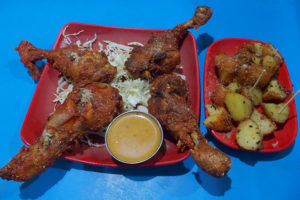
We found a restaurant in Kathmandu that served a variety of traditional Newari dishes and there were plenty of locals eating there which was a reassuring sign. It was hard to know what each menu item was so we went there several times and tried a bunch of different things. It opened our eyes to a world of savory treats. There are many different meat preparations that could be grouped together with subtle differences. Buffalo, or buff as they call it, is common but chicken, goat, and pork are available too. Sometimes the meat is partially dried or cured as in the case of buff sukuti and then cut into chunks and cooked with lots of spices, which also rehydrates it to some extent. Chewy and slightly crunchy buffalo jerky bites flash-fried and smothered in a tangy chili sauce. Yum. Other meat preparations are choila and sekuwa which are chunks of fresh meat cooked in spices. One is grilled and the other is boiled and pan fried but their seasonings can be very similar. They were all delicious, savory, and fulfilled a dietary void that had formed while in India. It’s worth noting that the seasoning for these dishes was totally different from anything we had in India. If anything it almost reminded me of a combination of Chinese and Mediterranean cooking, as odd as that may sound.
One of my favorites is the tawa meat dish. Pieces of fresh meat (I tried fish, pork belly, and chicken) are coated with a thick paste of spices and cooked in such a way that the spice layer browns and forms a crunchy spice coating. The spices have an earthy herbaceous flavor and the texture is perfect. I think the name tawa refers to a certain kind of pan that it’s cooked in – like a large shallow wok, which may in some cases have holes in it so that the cooking flame directly sears the meat and drains excess liquid.
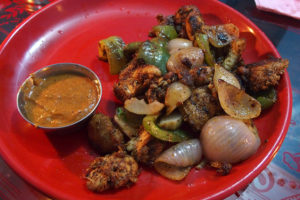
Many restaurants had “Newari sets” on the menu – a khaja set and sometimes a dhindo set. The backbone of the meal is the grain. Dhindo is like a warm dough made of various grains which is eaten in its dough-like form (with the fingers of course), as opposed to being made into bread. Khaja sets come with beaten rice instead, which is basically rice that has been cooked and rolled out flat and then dehydrated. It has a wonderfully crunchy texture, toasty flavor, and sticks very nicely to other saucy dishes. Fern and I both prefer it over regular rice in most cases. A khaja set will come with a pile of beaten rice surrounded by a handful of other dishes – a meat dish like chicken sekuwa, a crunchy, spicy soybean dish (bhatmas sadeko), and a vegetable which could be a nicely seasoned potato dish or maybe something along the lines of a vegetable curry. Usually there is some pungent pickled mango or pickled lime and sometimes a small bowl of a simple but rich and savory broth. I’m sure there are many variations depending on location and season but these meals are some of the best food that we’ve had while traveling. They are symphonies of texture and flavor wherein every bite is different than the one preceding it.
Since we spent several weeks in Pokhara we had plenty of opportunities to seek out good local food. We stayed away from the many westernized tourist restaurants because they tend to be many times more expensive and their offerings lack the special ingredients and flavors that make Nepali food interesting. A small place just down the street from our apartment became our regular spot. It was called Ambar’s Kitchen and it was run by a very friendly man named – that’s right – Ambar. It’s not a fancy place but his khaja sets were so delicious. They came with a choice of meat and my favorite by far was the bandel, which consists of succulent tender chunks of pork belly that are finished in a wok with a bunch of spices. Sometimes when Fern and I are having a hard time finding good food we fantasize about how great it would be to head over to Ambar’s for a khaja set and a bowl of his warming broth.
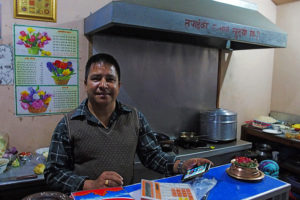
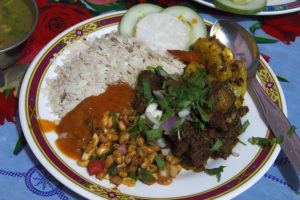
The last town we stayed in (in Nepal) was Tansen and while wandering the charming old streets we found a great place to eat. It was a hotel that didn’t seem to have a lot of publicity but it had a sign on the street with pictures of food, so we gave it a shot. They led us down to the dark concrete basement and turned the lights on when we got down there. It was lacking somewhat in the atmosphere department but we sat on a couple of pillows on the floor and asked to see a menu. The young man simply asked what we wanted. “Well, what do you have?” There was no menu and he started to write a couple of things on a pad of paper. It might seem like a lot of bad signals that would turn many away, in fact we never saw anyone else there, but somehow it was actually perfect. The young man had recently trained to be a hospitality industry cook and could make us whatever we wanted, as long as they had or could quickly get the ingredients. It was like we had our own personal chef, but it was still ridiculously inexpensive. It was basically just a family that lived there so the others helped out and the food was made as if it were being made for a family member.
Their buff momos (dumplings) were distinctive with a nice touch of sweet spices mixed with the meat, and the dipping sauce they brought out was one of the best. There are a lot of momos in Nepal but few of them are actually memorable.
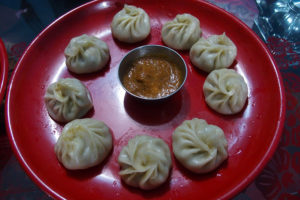
Another old stand-by that we had him make for us was the south Asian version of chili. It’s very common throughout Nepal and India and it’s basically a stir-fried meat (or paneer) with green pepper, onion, and sometimes tomato and smothered in a slightly sweet, very Chinese tasting chili sauce. Over the course of a few visits we had our personal chef make us many varieties of chili, the buff chili being one of the winners.
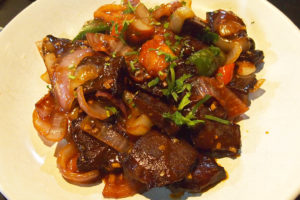
Since I had such a wonderful experience with my first tawa fish, I had to ask if he could make some sort of tawa dish, which he did beautifully. I originally asked for pork but he didn’t have any pork in the building since his family was doing chicken that night. So we got chicken. He offered to get pork the next day if we wanted to come back. The tawa chicken was so good that we had to come back. On our second visit when they brought out the food, I was pleasantly surprised that it was not just pork, but pork belly. Fern doesn’t care for the texture of the fatty pieces so I had to force myself to eat it all. Oh no. I can think of few culinary satisfactions as primal and decadent as that perfectly charred tawa pork belly melting in my mouth.
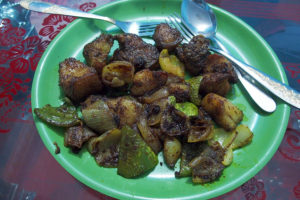
Overall our experience with dining in Nepal was wonderful. Sometimes it took a fair amount of walking to find what we were looking for but it was worth it. And it wasn’t just the meaty aspect of the food either. There is plenty of fertile land in the valleys and lots of water which makes for some robust vegetables. The greens are particularly nice as are the huge cauliflowers, legumes, eggplants, carrots, and giant daikon radishes. Going to small local markets to buy produce was a treat and because of the high quality of ingredients, it wasn’t difficult to make or find good food.
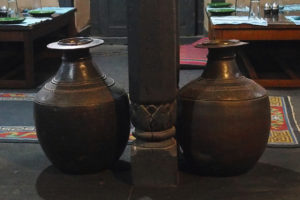
jim@snorkelbandits.com
